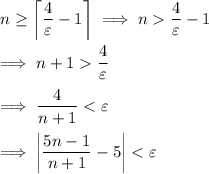The sequence converges to 5 as n goes to ∞. We can prove this rigorously:
The claim is that, for
 ,
,

By definition of the limit, this means for any ε > 0, there exists some N such that for any n larger than N, we have

In order to ensure this inequality, we work backwards to find N in terms of ε :

n is a natural number, so n + 1 > 0 and |n + 1| = n + 1. Then

Let N be the smallest natural number greater than or equal to 4/ε - 1, i.e.

Then the proof follows: suppose

Then

as required.
Or we can avoid the rigor and use some facts we know about limits:

since 1/n converges to 0 as n goes to ∞.